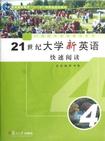普通高等教育十一五国家级规划教材
出版时间:2012-6 出版社:复旦大学出版社 作者:邹申,汪榕榕,陶文好,等 编 页数:153
前言
在互联网高速发展的信息时代,我们需要阅读的英语资料浩如烟海,仅靠延长阅读时间来获取知识和信息的办法显然已不能适应时代发展的要求。因此,增加大学英语快速阅读教学,培养和训练学生的快速阅读能力,就成为大学英语教学中不容忽视的一项重要内容。 根据2007年国家教育部高教司颁布的《大学英语课程教学要求》(以下简称《课程要求》),大学英语的教学目标是培养学生的英语综合应用能力。而阅读作为一项基本技能,始终是英语综合能力训练中的一个重要环节。从一定意义上讲,阅读速度又是衡量阅读能力的重要指标之一。《课程要求》提出了三个层次的英语教学要求,其中的“一般要求”和“较高要求”均对快速阅读能力作了详细说明。快速阅读的一般要求是能够应对篇幅较长、难度略低的材料,阅读速度应达到每分钟100词,并能就阅读材料进行略读(skimming)和寻读(scanning);而较高要求是要能够应对篇幅较长、难度适中的材料,并且阅读速度达到每分钟120词。而且两个要求均提出学生通过阅读能够掌握中心大意,理解主要事实和有关细节。由此可见,深化快速阅读教学,进一步提高阅读能力,仍是培养和提高大学生语言运用能力的关键所在。 本系列教材是以《大学英语课程教学要求》为准则,在参考国内外多种英语快速阅读教材的基础上,根据编者多年从事大学英语快速阅读教学的经验,以及我国非英语专业本科生目前整体英语水平和实际英语能力编写而成。 ……
内容概要
《21世纪大学新英语系列:21世纪大学新英语快速阅读4》共分六册,旨在帮助学生进行系统的、有针对性的快速阅读训练,掌握基本阅读技能,培养良好阅读习惯,提高阅读效率。选材方面,我们力求所选文章兼备时代性、信息性、趣味性以及可读性,语言难度适中,其体裁和题材体现多样性,话题涵盖中西文化、教育、生活、媒介、历史、科技、哲学、文学等。练习方面,我们主要以现行大学英语四六级考试中快速阅读题型为主,又适当增加其他形式的题型:既有选择填空、对错判断和填空等基本题型,又有匹配、简短回答、摘要以及翻译等练习。目的是使学生在学习完本套教材后提高快速阅读部份的应试能力,同时又增强他们的信息搜索能力。每册书后附有本册练习的参考答案供师生参考。 《21世纪大学新英语系列:21世纪大学新英语快速阅读4》共分八个单元,每个单元由Passage A、Passage B和Passage C三篇文章组成。Passage A和Passage B供课堂使用,Passage C供学生课外阅读。
书籍目录
Unit 1 COLLEGE EDUCATIONPassage 1 Universities Branch OutPassage 2 What Good Is a College Education Anyway?Passage 3 Colleges Taking Another Look at Value ofMerit-based AidUnit 2 SCIENCE AND SUPERSTITIONPassage 1 Bermuda Triangle: Behind the IntriguePassage 2 Are You Superstitious?Passage 3 What Is Science? What Is Pseudoscience?Unit 3 OLD AND YOUNGPassage 1 The New Old and the Conserva-teenPassage 2 The Secrets of Long Life Revealed?Passage 3 Reverse AgeismUnit 4 SPORTS AND HEALTHPassage 1 The Truth about Sports and Weight LossPassage 2 Health Benefits of ExercisePassage 3 The Role of Exercise in My LifeUnit 5 HAPPINESSPassage 1 How to Find Happiness in a Nine to Five JobPassage 2 Finding Happiness: How to Appreciate the Little Things in Life - Small Ways to Find Joy in the Everyday ExperiencePassage 3 Three Treasure Boxes - The Pursuit of HappinessUnit 6 ECOLOGYPassage 1 We Can't Wish Away Climate ChangePassage 2 Going Green Without Going BrokePassage 3 Overpopulation Is the Main Threat to the PlanetUnit 7 TECHNOLOGY AND PROGRESSPassage 1 Does Technology Improve Quality ofOur Lives?Passage 2 Technology and Our Dependence upon ItPassage 3 Caught in the Web - Undesirable Effect oflnternet TechnologyUnit 8 HUMANITY AND NATUREPassage 1 A Grassroots RemedyPassage 2 The Nature of Human Body - Chinese Explanation of Body ClockPassage 3 An Unlikely Way to Save a Species: Serve It for DinnerAppendixKeys and Answers
章节摘录
1.As never before in their long story, universities have become instruments of national competition as well as insttuments of peace. They are the place of the scientific discoveries that move economies forward, and the primary means of educating the talent requited to obtain and maintain competitive advantages. But at the same time, the opening of national borders to the flow of goods, services, information and especially people has made universities a powerful force for global integration, mutual understanding and geopolitical stability. 2.In response to the same forces that have driven the world economy, univetsities have become more self-consciously global: seeking students from around the world who represent the entire range of cultures and values, sending their own students abroad to prepare them for global careers, offering courses of study that address the challenges of an interconnected world and collaborative (合作的) reseatch programs to advance science for the benefit of all humanity. 3.Of the forces shaping higher education none is more sweeping than the movement across borders. Over the past three decades the number of students leaving home each year to study abroad has grown at an annual rate of 3.0 percent, from 800,000 in 1975 to 2.5 million in 2004. Most travel from one developed nation to another, but the flow from developing to developed countries is growing rapidly. The reverse flow, from developed to developmg countries, is on the rise, too. Today foreign students earn 30 percent of the doctotal degrees awarded in the United States and 38 percent of those in the United Kingdom And the number crossing borders for undergraduate study is growing as well, to 8 percent of the undergraduates at America's best institutions and 10 percent of all undergraduates in the U.K. In the United States, 20 percent of the newly hired professors in saence and engineering are foreign-born, and in China many newly hired faculty members at the top research universities received their graduate education abroad. 4.Universities are also encouraging students to spend some of their undergraduate years in another country. In Europe, more than 140,000 students participate in the Erasmus program each year, taking courses for credit in one of 2,000 partiapating institutions across the continent. And in the United States, institutions are helping place students in summer internships(实习) abroad to prepare them for global careers. Yale and Harvard have led the way, offering every undergraduate at least one international study or internship opportunity and providing the finanaal resources to make it possible. 5.Globalization is also reshaping the way research is done. One new trend involves soutcing portions of a research program to another country. Yale professor and Howard Hughes Medical Institute investigator Tian Xu directs a research center focused on the genetics of human disease at Shanghai's Fudan University, in collaboration with faculty colleagues from both schools. The Shanghai center has 95 employees and graduate students workingin a 4,300-square-meter laboratory facility. Yale faculty, postdoctots and graduate students visit regularly and attend videoconference seminars with scientists from both campuses. The arrangement benefits both countries, Xu's Yale lab is more productive, thanks to the lower costs of conducting research in China, and Chinese graduate students, postdoctors and faculty get on-the-job training from a wodd-class scientist and his U.S. team. ……
图书封面
评论、评分、阅读与下载
